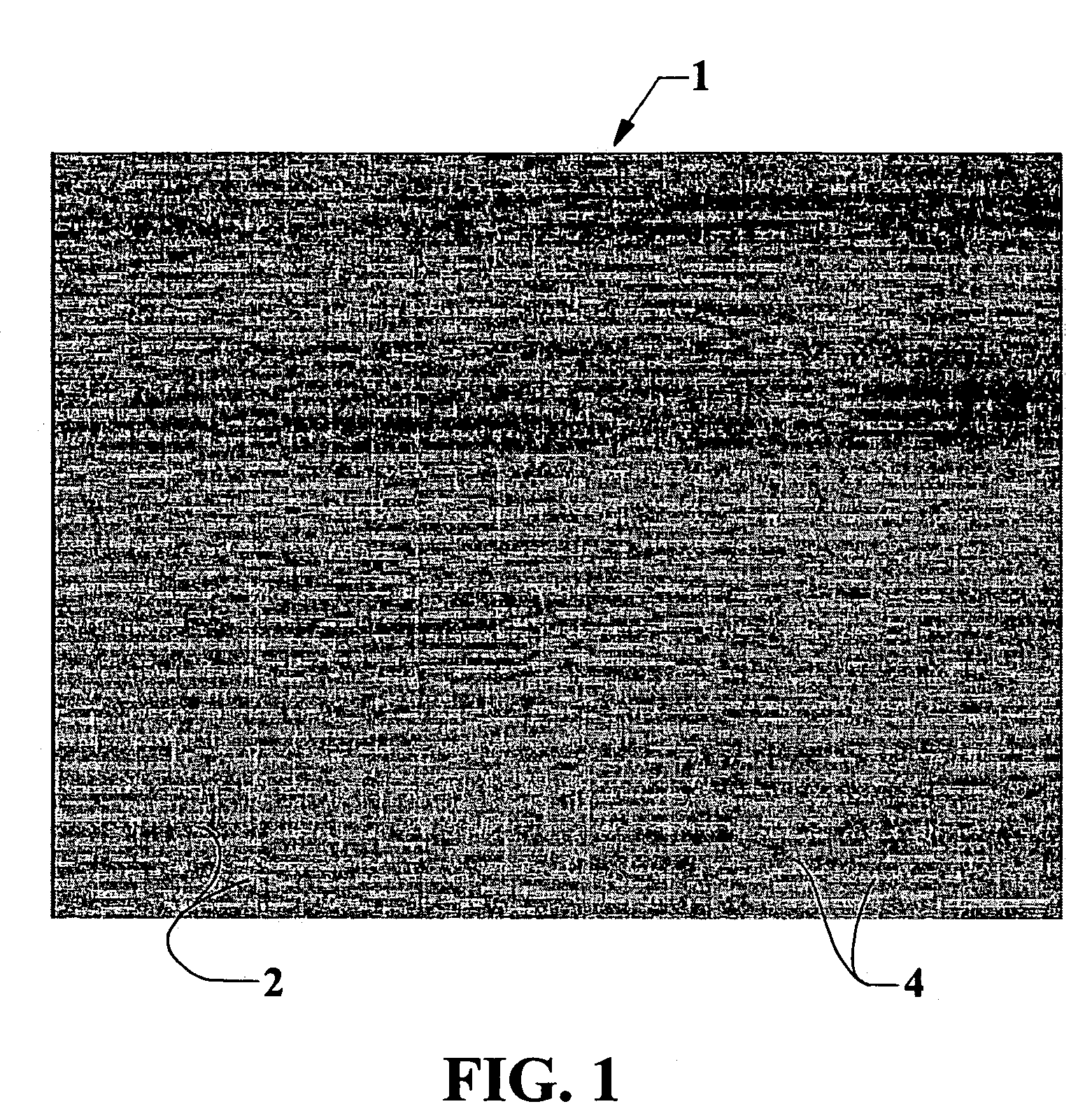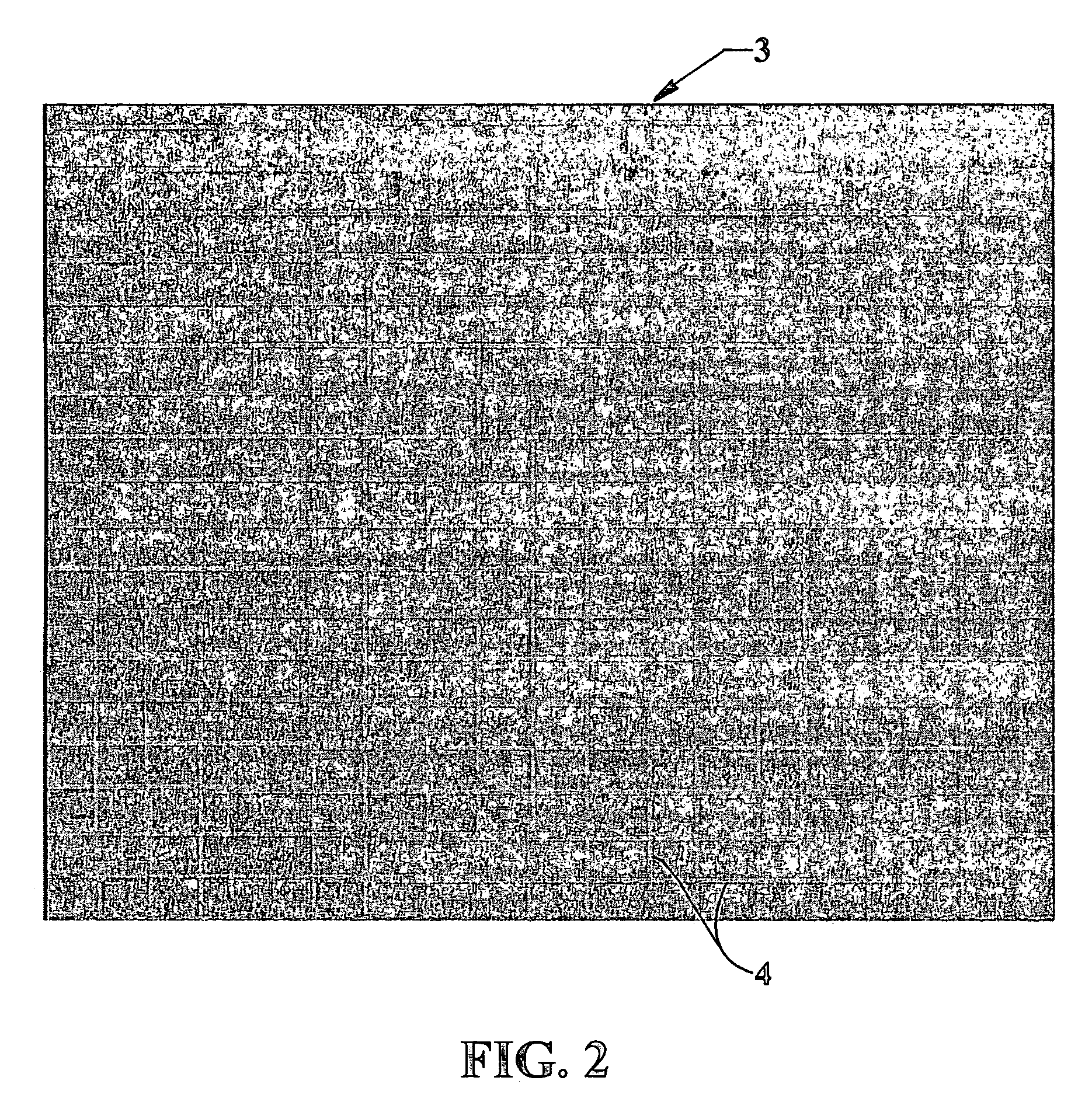Reinforced nonwoven fire blocking fabric having ridges and grooves and articles fire blocked therewith
a non-woven, ridge-shaped technology, applied in the field of reinforced non-woven fabrics, can solve the problems of reducing the aesthetics of the mattress, limiting the ability of the fabric to bulk when heated or exposed to flame, and reducing the process of incorporating the fabric into the mattress
- Summary
- Abstract
- Description
- Claims
- Application Information
AI Technical Summary
Benefits of technology
Problems solved by technology
Method used
Image
Examples
example 1
[0050]A reinforced nonwoven fabric was prepared as follows. 80 parts by weight 2.2 dpf, 2″ cut length Type 970 Kevlar ® brand staple fiber and 20 parts 4 dpf, 2″ cut length Type 4080 Unitika binder fiber were blended as fed from bales to two cards. Fiber webs from the two cards were collected on a transporting belt to create a fiber web having a basis weight of approximately 132 grams per square meter. An open mesh scrim of polyester filament yarn was inserted between the two webs formed by the first two cards. The open mesh scrim was a Bayex® PQRS4351 / R17 scrim. The resulting structure had one carded web on one side of the open mesh scrim and one carded web on the other side of the scrim.
[0051]EMS Griltex 6E P82 / 029 polyester -type adhesive powder was applied to the combined webs and scrim in an amount that brought the total sheet weight to approximately 132 grams per square meter. The combined webs, binder powder, and scrim were conveyed through an oven at 140° C. (285° F.) to act...
example 2
[0055]A reinforced nonwoven fabric was prepared as in Example 1 except the polyester binder fibers were replaced with an essentially equal amount of Griltex PA Biko BA 140 8 dpf, 2-inch cut-length nylon binder fibers.
[0056]The final composition of the fabric was approximately 59% Kevlar® fiber, 15% binder fiber, 19% polyester scrim and 7% binder powder. The compressed fabric had a weight of 124 grams per square meter and the fabric had a thickness of approximately 23 mils per ASTM D1777-96 Option 1. The fabric had an elongation under load (ASTM D5034 (mod)) of 0.6 percent at a weighting of 2 pounds per inch. The permanent set after 15 minutes (ASTM D5034 (mod)) was 0.1 percent.
[0057]The fabric was then micro-crimped or micro-creped as before, but by using a compaction rate of approximately 15%, which in turn provided a sheet having approximately 12.4 ridges per lineal inch. While the fabric had more ridges per linear inch, the amplitude of the ridges and grooves was lower. The fabri...
example 3
[0058]This example illustrates the bulking behavior of the reinforced fabric of this invention. A reinforced nonwoven fabric was prepared similar to Example 1. This fabric had an initial thickness 0.074 in (1.9 mm). Samples of the fabric were placed in a heated oven operating at different temperatures and the time noted when initial bulking of the sample was visually detected. Visual monitoring of the samples continued and the time to essentially full bulking of the samples varied with temperature, with essential full bulking occurring at about five minutes for the sample tested at 150° C. to about 1.5 minutes for the sample tested at 250° C. The samples remained in the oven for a total of 15 minutes and the final bulking thickness recorded. The final bulked thicknesses of the samples were measured by using a Measure-Matic gauge at 0 load (ASTM D5736-95) and are shown in the Table.
[0059]
TABLEDurationInitial Bulking TimeThicknessSample #Temp (° C.)(min)(sec)(mils(mm))AControl—— 74 (1...
PUM
| Property | Measurement | Unit |
|---|---|---|
| thickness | aaaaa | aaaaa |
| thickness | aaaaa | aaaaa |
| temperatures | aaaaa | aaaaa |
Abstract
Description
Claims
Application Information
 Login to View More
Login to View More - R&D
- Intellectual Property
- Life Sciences
- Materials
- Tech Scout
- Unparalleled Data Quality
- Higher Quality Content
- 60% Fewer Hallucinations
Browse by: Latest US Patents, China's latest patents, Technical Efficacy Thesaurus, Application Domain, Technology Topic, Popular Technical Reports.
© 2025 PatSnap. All rights reserved.Legal|Privacy policy|Modern Slavery Act Transparency Statement|Sitemap|About US| Contact US: help@patsnap.com


